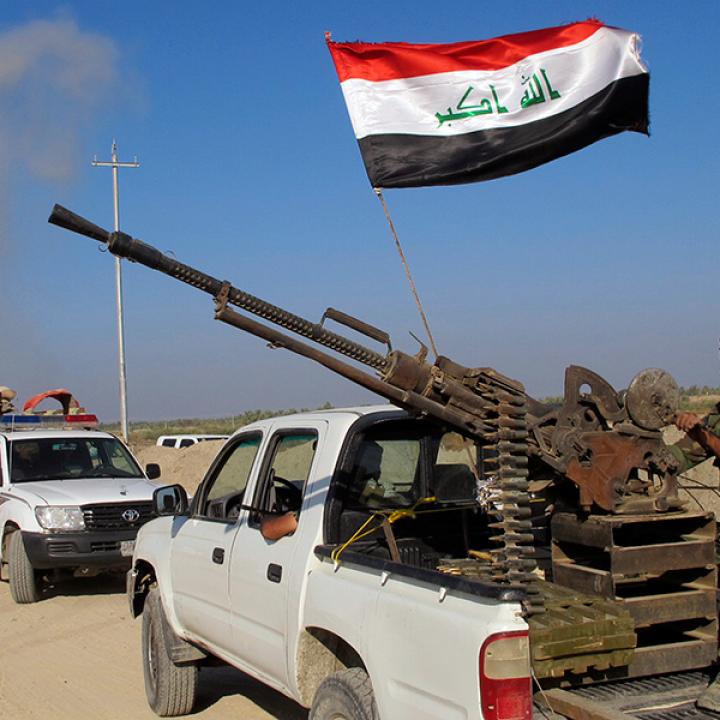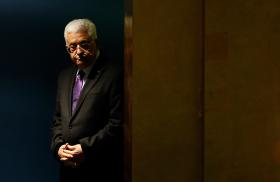
- Policy Analysis
- Fikra Forum
Building a “Joint Force” to Control Liberated Yazidi Towns

More than two weeks after the launch of the Muhammad Rasallah II operation, the Popular Mobilization Units (PMUs, or al-Hashd al-Shabi) reached the Syria-Iraq border west of Mosul on May 29, 2017. Hadi al-Ameri, leader of the Badr Organization and one of the most influential PMU commanders, announced from the border that the PMUs will "clear the borders from this point down to al-Qaim" in Anbar province. Ameri had previously called these operations "the battle of the borders."
It seems clear that the Muhammad Rasallah II operation was not only an attempt to strike a blow at the so-called Islamic State (IS) but also a concerted effort by the Iraqi government and the PMUs to redeploy federal forces into areas that were previously controlled by the Kurdistan Regional Government (KRG). The PMUs expelled IS from a string of Yazidi towns and villages in south Sinjar. Qahtaniyah was the last important Yazidi town to be cleared by the PMUs on May 28. These Yazidi areas are located inside the Disputed Internal Boundary (DIB) districts, which are claimed by both Baghdad and the Kurdistan region. Clearly, the PMU move was carefully planned because Yazidi PMU forces, the Lalish regiment, were quickly established in the recently liberated areas. The PMUs were welcomed by the Yazidi-manned Sinjar Resistance Units (YBS) and the final phase of the operation was named under the slogan "Martyrs of Sinjar" as a reminder of Yazidi suffering.
For the KRG, the advance of the PMUs into Yazidi areas is a bitter pill. The Yazidi genocide occurred because the KRG security mechanism failed in areas such as Sinjar, Qaraywan, and Qahtaniyah. The KRG liberated Sinjar but has since feuded with the Yazidi YBS and Kurdistan Workers Party (PKK) fighters in the area. After sitting just twenty kilometers to the north of the Yazidi towns for the last year, the KRG Peshmerga just watched the PMUs sweep past them to control the area. In the early days of the Muhammad Rasallah II operations, the president of the KRG, Masoud Barzani, reportedly told Sinjar officials that "Hashd must not enter those [Yazidi] areas." The PMU advance has made the KRG look weak and may invite tests of Kurdish control by the PMUs in other disputed areas like Tuz Khormatu, northern Diyala, and the Ninawa Plains, east of Mosul. Kurdish leaders have suggested that a redline, for them, may have been crossed. Hoshyar Zebari, former Iraqi foreign minister and a prominent figure in the Kurdistan Democratic Party (KDP), voiced the Kurdish concerns on this. He told al-Sharqiya news on May 30 that "we are witnessing an expansion by the PMUs, not only on the Kurdistan region's borders but inside the region itself."
Baghdad has fully backed the PMU operation but has also sought to reduce tensions with the Kurds. Just one day after the launch of Muhammad Rasallah II, Iraqi defense minister Arfan al-Hayali and the overall commander of the Ninawa liberation, Lt. Gen. Abdul Ameer Rasheed Yarallah, visited the PMU headquarters in Tal Abta and held a joint news conference with PMU deputy commander Abu Mahdi al-Muhandis. On May 29, Prime Minister Haider al-Abadi visited the Tal Abta headquarters and stressed that all PMU operations in west Ninawa are conducted under his command. The next day, Abadi reiterated that statement, saying, "All our security forces are under the General Command of the Armed Forces...including the PMUs...And I want to emphasize, including the PMUs." He added that "the PMUs did not drive toward the borders all by themselves." With these statements, Abadi tried to show that the PMUs would remain under Iraqi government control and would not act against the Kurds in the future.
Abadi's words -- and a visit to Kurdistan by Faleh al-Fayyad, the Iraqi national security advisor and head of the PMUs -- have done little to lessen Kurdish anger and fear. Recent polling by the National Democratic Institute in April and May found the Kurds to be the Iraqi community most strongly opposed to and most fearful of the PMUs . For instance, 85% of Kurdish respondents had an unfavorable view of the PMUs, versus 23% in the Sunni areas of Iraq, and 80% of Kurds want the disbandment of the PMUs. Abadi's last hope of reassuring the Kurds may be the formation of unified military command for the newly liberated areas in Qaraywan and Qahtaniyah. On May 30, Abadi talked about this plan: "[These operations] are not an expansion...We have agreed [with the KRG] to form a joint force that includes Iraqi forces, including the Peshmerga...to control [these areas]."
Building such a joint force is a daunting challenge. Before the IS advance in 2014, areas like Sinjar, Qaraywan, and Qahtaniyah were split between federal and KRG control. The towns were secured by Peshmerga and Kurdish intelligence forces, while the rural areas were patrolled by federal Iraqi army forces -- mostly Yazidi troops -- and border guards. Now the situation is even more complex. In addition to the Kurds, the PMUs, and the Iraqi army, the area also contains the PKK and an array of Yazidi militias, some pro-KRG, some pro-PMU, and some, like the YBS, tied to the PKK. Local police forces and border guard units need to be formed, and the six main Iraqi intelligence agencies plus their Kurdish equivalents will be active in the area.
Then there is the foreign involvement of Turkey, the PKK, Iran, and Syria. Turkey will be most content if the proposed joint force includes the KRG, Iraqi police and army, and local Yazidis. This will mean the weakening of the PKK-affiliated forces in Sinjar as well as the exclusion of the Shia elements of the PMUs and inclusion of its ally, the KDP, in the game. The PKK will seek to maintain its special relationship with the Yazidi YBS, but it will now be squeezed by the KRG-Turkey alliance on one side and expansionist PMUs on the other, both of which view the PKK as an unwanted complication to their local agendas. For example, it should not be assumed that the PKK-affiliated forces in Iraq and Syria will necessarily support the development of an Iranian-controlled corridor between Iran and the Mediterranean.
When trying to weave together these disparate elements, one model that Iraq may wish to adapt is the Combined Security Mechanism (CSM) system that was established in December 2009, initially to forge Kurdish-Baghdad cooperation in securing the March 2010 Iraqi elections in the disputed areas. U.S. forces facilitated and "umpired" the operation of a Ninawa Combined Cooperation Center in which Iraqi and Kurdish generals and staff officers worked together to jointly authorize troop movements in the so-called Combined Security Areas (CSAs). A system of jointly manned Combined Check Points controlled key geographic points and road junctions. Though the system was not perfect, and required the United States to act as an honest broker, the result was fewer unintended clashes between Iraqi and Kurdish forces and greater stability. With Ninawa Provincial Council elections due later this year -- and likely to take place in spring 2018 alongside Iraqi national elections -- there is a clear rationale for a new CSM-type system.
Building such a system will be far more difficult now. Unlike in 2009, the United States does not have tens of thousands of troops in Iraq. Nor is the United States operating as the sole intervening power; now many elements of the PMUs are anti-American militias controlled by Iranian proxies like PMU deputy commander Muhandis, a U.S.-designated terrorist. The potential role for the Combined Joint Task Force (CJTF) Operation Inherent Resolve would need to be lower-profile than in the CSM days. Iraqi leaders would need to form a senior working group and set the rules of the road in disputed areas. Iraqi, Kurdish, and Yazidi factions would lead on the ground, and there would be practically no CJTF involvement at the checkpoint level. Instead the CJTF contribution could be at the Combined Cooperation Center level, with a small liaison staff and intelligence assets to help monitor dangerous situations and track movements.
Due to their special concern regarding the PMUs, the Kurds need to be reassured by the presence of what Iraqis call the "formal forces" of the government (al-quwwat al-rasmiyya, meaning the Iraqi army, Counter-Terrorism Service, border guards, and police). Such forces need to be allocated strong logistical support to rebuild their bases in the desert areas and receive food, water, and fuel supplies, which are needs that CJTF may be able to meet until infrastructure has been reconstructed. A trial run for the new joint force might cover the period from now until Iraqi (and Ninawa) elections in 2018. Only with such a system in place will the elections be held in the liberated areas west of Mosul, and only if all factions are present will the results be accepted. If Ninawa has no elected provincial council, it will have no basis for long-term normalization. Iraqi-Kurdish leadership and international assistance for a joint force will be a critical factor in securing the gains that have been made on the battlefields of Ninawa.



